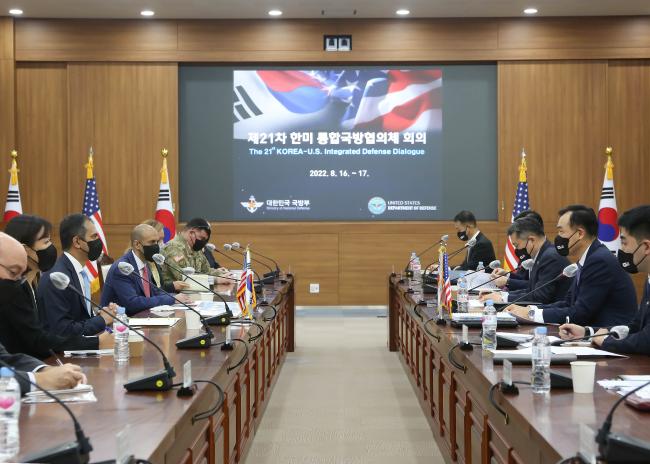At the Korea-US Integrated Defense Dialogue,
defense ministries of the two countries agree to respond sternly to North Korean nuclear test by deploying US strategic assets,
discuss ways to strengthen ROK-US-Japan trilateral security cooperation

The defense ministries of the Republic of Korea (ROK) and the United States (US) reaffirmed their common goal of completely denuclearizing the Korean Peninsula and agreed to maintain a readiness to defend the ROK. In keeping with this, the two sides agreed to expand the range and scale of joint military exercises and training in the Korean Peninsula region on the sidelines of the ‘Ulchi Freedom Shield (UFS)’ exercise, which will begin in earnest on August 22 in consideration of North Korea’s evolving threats. Significantly, the two sides shared the view that they will respond sternly to North Korea’s action of carrying out its nuclear test by deploying US strategic assets in the region.
In a statement, the ministry said that the two sides had discussed the matters at the 21st meeting of the Korea-US Integrated Defense Dialogue (KIDD) held in Seoul from August 16 to 17. The meeting was attended by top defense officials and diplomats from the two countries, including Deputy Defense Minister for Policy Heo Tae-keun and US Deputy Assistant Secretary of Defense for East Asia Siddharth Mohandas as the respective principal representatives. The two representatives discussed the North Korean threat, focusing on the increased frequency and scale of North Korea’s missile test launches over the past year, and affirmed that it is important for the international community to completely implement UN Security Council resolutions. They also shared the movement and assessment of North Korea’s Punggyeri nuclear test site.
During the high-level meeting at the KIDD, the two sides reaffirmed the importance of observing ‘rules-based international order’ based on international laws and norms, such as freedom of navigation, and agreed to cooperate closely to deal with challenges in the region. As reflected in the joint statement made at the ROK-US summit in May 2022, the two sides also clarified their stance of observing international laws, including maintenance of peace and stability in the South China Sea and other seas, free and legal economic activities, freedom of navigation and overflight, and ensuring the lawful use of the ocean.
The two sides also shared the view on the importance of maintaining peace and safety in the Taiwan Strait. Significantly, the two sides agreed to cooperate closely so that the ‘Indo-Pacific Strategic Framework,’ which the ROK is mapping out, and the US’s Indo-Pacific strategy can contribute to building peace and stability in the region.
The two sides also agreed to further strengthen the ROK-US-Japan trilateral cooperation, sharing the assessment that the ROK-Japan General Security of Military Information Agreement continues to play an important role in both ROK-Japan bilateral cooperation and ROK-US-Japan trilateral security cooperation. As an extension of this, the two sides agreed to deepen bilateral cooperation through the yearly ROK-US-Japan Defense Trilateral Talks (DTT). Regarding the TTHAD base, the two sides put a high value on the improvement in access to the base, including an increase in the number of times materials are supplied from three times to five times a week.
During the meeting of the Deterrence Strategy Committee (DSC) held on the sidelines of the KIDD, the two sides shared the view that the revision of the ROK-US Tailored Deterrence Strategy (TDS), which had been discussed at the 53rd Security Consultative Meeting (SCM), has made progress. The DSC was co-hosted by Heo, Principal Deputy Assistant Secretary of Defense for Space Policy Vipin Narang, and Deputy Assistant Secretary of Defense for East Asia Mohandas. The US side emphasized its ironclad commitment to defending the ROK to operate all categories of military capabilities, including nuclear and conventional missile defense capabilities and advanced non-nuclear capabilities, while the ROK side emphasized its willingness to strengthen the ‘Korean three-axis system’ to deter and respond to North Korea’s advancing nuclear and missile threats. To this end, the allies agreed to hold the Extended Deterrence Strategy and Consultation Group (EDSCG) this September and carry out the DSC Table Top Exercise (TTX) in early stages. The allies also agreed to establish a counter-missile working group (CMWG) in the DSC, in order to beef up the alliance missile response capabilities and posture and maintain close policy cooperation and communication.
By Chae-Mu, Im <lims86@dema.mil.kr >
<Copyright ⓒ The Korea Defense Daily, All rights reserved>